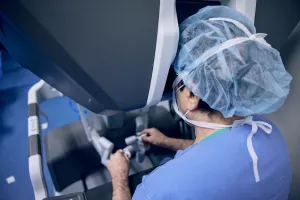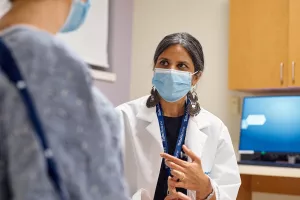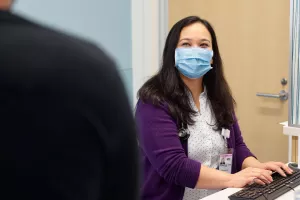If you’re living with a serious condition affecting your thoracic region (including the lungs, esophagus and mediastinum, the area between the lungs, trachea and diaphragm) our team of thoracic surgeons provides expert diagnosis and innovative treatments designed to ensure your experience is a comfortable as possible.
Robotic surgery, remarkable results
At Tufts Medicine, our expert surgeons specialize in treating lung, esophageal, and other chest cancers through minimally invasive robotic technology that uses small incisions so that you can get back to living your best life as quickly as possible. Robotic-assisted surgery improves precision by using small instruments that mimic the hand. Smaller incisions may lead to shorter hospital stays, decreased pain after surgery, and quicker recovery.

Conditions
Surgery can be a treatment solution for conditions that affect the chest area. These include the lungs, esophagus and mediastinum — the area between the lungs, trachea and diaphragm. We treat the following conditions and more:
Testing
Your care team will determine the right tests based on your symptoms and medical and family health history. This can include a series of imaging tests, breathing tests and potential biopsy which involves taking a small sample to examine it more closely.
Imaging tests
We work with our colleagues in radiology to get a clear picture of your thoracic region. We may order one or more of the following diagnostic imaging tests to help us make informed decisions about your health.
Additional thoracic tests
Pulmonary function test
This test lets us know how your lungs are working. It measures how much air you can breathe in and out and how well the lungs deliver oxygen to your bloodstream
Bronchoscopy and biopsy
We'll use advanced technology to check every part of your lungs, inside and out. A robotic bronchoscope will navigate your lung's complex paths, making biopsies safer and more precise. In this procedure, we pass a small camera into your airways and lung that is safely navigated to the area of concern for further testing.
Treatments
We’re always in pursuit of what’s next in healthcare and what’s next for your thoracic health. That’s why we offer the latest in minimally invasive surgical procedures to get your life back on track faster.
Bronchoscopic procedures
The lungs are delicate and can be difficult to reach because of their location. But a bronchoscope — a thin, flexible tube about the size of a pencil eraser — enables us to treat all kinds of pulmonary conditions. This tool lets us perform various procedures, from washing your airways to reducing the thickness of lung muscles to allow for easier breathing
Thymectomy
A thymectomy is a minimally invasive surgical procedure that removes the thymus gland, which is located behind the breastbone. A thymectomy is a common treatment for myasthenia gravis, which is an autoimmune disease that weakens your skeletal muscles.
Robotic-assisted surgery
Our thoracic surgeons are experts in robotic-assisted surgery, including the state-of-the-art da Vinci® Surgical System, which has been used for over 8.5 million successful surgeries worldwide.
This technology can be used for complex chest, lung, esophagus and stomach procedures. By making just a few small incisions, the surgical system provides a detailed 3D view of the affected area. Having a high-definition view of your insides empowers our doctors with greater precision, control and streamlined communication between the surgery team.
Treating achalasia
Achalasia is an esophageal disorder in which food doesn’t move properly from the mouth to the stomach. It occurs when nerves in the esophagus and lower esophageal valve are damaged or destroyed, affecting the esophageal's typical movements.
We can treat achalasia with endoscopic therapies or surgery. Endoscopic therapies like pneumatic dilation or Botox injections can temporarily improve your symptoms. Meanwhile, surgery can offer a permanent solution for your condition.
Laparoscopic Heller myotomy surgery
Laparoscopic Heller myotomy surgery is a minimally invasive method for opening the lower esophageal sphincter (LES) to relieve difficulty swallowing. It involves making several small incisions in the abdomen, through which we then insert tiny medical instruments and a camera. These tools guide the doctor as they cut through the muscular layer of the lower end of the esophagus and the upper area of the stomach. This type of surgery is also known as a myotomy.
We can also address gastric reflux during this procedure by using a process called fundoplication. To prevent acid from rising into the esophagus, we wrap a part of the stomach around the esophagus.

From regular office visits to inpatient stays, find the healthcare you need and deserve close to home.

Meet the doctors and care team devoted to supporting you every step of the way along your path to better health.